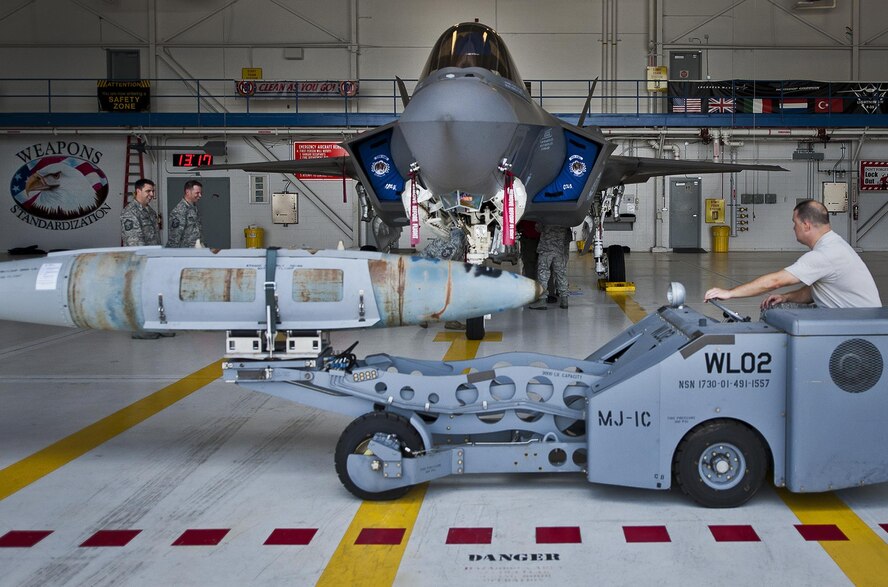 By Lt. j.g. Lisa Lill, 33rd Fighter Wing Public Affairs
By Lt. j.g. Lisa Lill, 33rd Fighter Wing Public Affairs
EGLIN AIR FORCE BASE, Fla. (AFNS) --
After months of preparation the weapons troop standardization
load crew, or SLC, from the 33rd Maintenance Group performed the first
munitions load verification on the F-35A Lightning II here Aug. 27.
"Over the next couple of days, our 33d Fighter Wing maintenance professionals, alongside representatives from the F-35 Program Office and Air Combat Command, will validate weapons loading procedures. This involves loading and unloading laser-guided and GPS-guided bombs, and air-to-air missiles into the weapons bays of the aircraft and ensuring the instructions we provide our load crews are accurate and effective - one more step towards F-35 initial war fighting capability," explained Lt. Col. Ron Huzzard, the deputy commander of the 33rd MXG.
The SLC has been practicing this load verification using a series of tabletop exercises for several months. This marked the first hands-on load verification for the crew.
"Watching our weapons troops verify loading procedures was like getting a glimpse into the future. Ultimately, this will be the work that is performed down range when it counts, and we are laying that foundation here at Eglin," said Navy Capt. Lance Massey II, the commander of the 33rd MXG. "The stealth capability on the F-35 is beyond incredible, but the weapons capability rounds out the whole purpose of the joint strike fighter."
The procedure was overseen by Chief Master Sgt. Christopher Wilbur, the wing weapons manager at the 33rd MXG.
"The Airmen walked through the technical instructions to verify the data is accurate and make adjustments as necessary," Wilbur said about the verification load exercise.
The three-person SLC included Master Sgt. Karen Griffin, Tech. Sgt. Russell Fontaine and Staff Sgt. Steven Dash. Working as a cohesive team, the trio carefully performed several iterations of loading and unloading four different munitions. Once the procedures are verified SLC members will train the weapon troops.
"Getting this step verified in ALIS (the automated logistics information system) for the F-35A is important, so we can move forward and get our 60-plus maintainers trained and working," Griffin said.
"Over the next couple of days, our 33d Fighter Wing maintenance professionals, alongside representatives from the F-35 Program Office and Air Combat Command, will validate weapons loading procedures. This involves loading and unloading laser-guided and GPS-guided bombs, and air-to-air missiles into the weapons bays of the aircraft and ensuring the instructions we provide our load crews are accurate and effective - one more step towards F-35 initial war fighting capability," explained Lt. Col. Ron Huzzard, the deputy commander of the 33rd MXG.
The SLC has been practicing this load verification using a series of tabletop exercises for several months. This marked the first hands-on load verification for the crew.
"Watching our weapons troops verify loading procedures was like getting a glimpse into the future. Ultimately, this will be the work that is performed down range when it counts, and we are laying that foundation here at Eglin," said Navy Capt. Lance Massey II, the commander of the 33rd MXG. "The stealth capability on the F-35 is beyond incredible, but the weapons capability rounds out the whole purpose of the joint strike fighter."
The procedure was overseen by Chief Master Sgt. Christopher Wilbur, the wing weapons manager at the 33rd MXG.
"The Airmen walked through the technical instructions to verify the data is accurate and make adjustments as necessary," Wilbur said about the verification load exercise.
The three-person SLC included Master Sgt. Karen Griffin, Tech. Sgt. Russell Fontaine and Staff Sgt. Steven Dash. Working as a cohesive team, the trio carefully performed several iterations of loading and unloading four different munitions. Once the procedures are verified SLC members will train the weapon troops.
"Getting this step verified in ALIS (the automated logistics information system) for the F-35A is important, so we can move forward and get our 60-plus maintainers trained and working," Griffin said.









